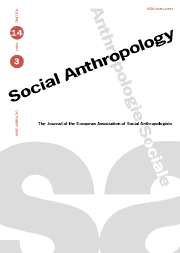Illness-images and joined beings. A critical/Nayaka perspective on intercorporeality
Published online by Cambridge University Press: 13 December 2004
Abstract
This paper examines an indigenous complex of ideas about illnesses, misfortunes and trances in relation to the concept of ‘intercorporeality’, as discussed by Weiss and Waldby. Intercorporeality helps us understand some Nayaka senses of batha, and sheds light on the relational nuances of this indigenous notion. Batha suggests another rendition of intercorporeality, which does not pluralise the individual's ‘inside’ as a composite embodiment of exterior relations, classes and hierarchies. Rather, this indigenous category underscores the sense of an irreducible plurality of ‘relatives’, each joined to all the others, constituting a web of mutualities that transcend classes and boundaries, including even human/non-human.
Cet article examine un complexe indigène d'idées concernant des maladies, infortunes et transes en relation avec le concept d' ‘intercorporalité’, tel qu'il a été discuté par Weiss et Waldby. L'intercorporalité nous aide à comprendre certains sens du batha chez les Nayaka, et met en lumière les nuances relationnelles de cette notion indigène. Batha suggère une autre interprétation de l'intercorporéalité qui ne pluralise pas ‘l'intérieur’ de l'individu comme une incarnation composite de relations, de classes et de hiérarchies extérieures. Cette catégorie indigène souligne plutôt le sentiment d'une pluralité irréductibles de ‘parents’, chacun unis à tous les autres, constituant un réseau de mutualités qui transcende les classes et les frontière, même celle humain/non-humain.
Dieser Beitrag untersucht einheimische Ideen über Krankheit, Missgeschicke und Trance in Verbindung mit dem von Weiss postuliertem Konzept der Interkorporalität. Interkorporalität hilft uns bestimmte Nayaka Sinne, wie zum Beispiel batha, zu verstehen und wirft Licht auf die relationalen Nuancen dieser einheimischen Vorstellungen. Batha suggeriert einen anderen Begriff von Interkorporalität, der das individuelle Innere nicht als pluralisierte Verkörperung der äußeren Beziehungen, Klassen und Hierarchien auffasst. Diese einheimische Kategorie unterstreicht vielmehr eine nicht reduzierbare Pluralität von Relativen, jedes verbunden mit allen anderen und so ein Netz der Gegenseitigkeiten konstituierend, das Klassen und Grenzen – auch die des Menschlichen/Nicht-menschlichen – übersteigt.
Este artículo examina un complejo nativo de ideas sobre enfermedad, desgracias y trances en relación al concepto de ‘intercorporalidad’, discutido por Weiss y Waldby. La intercorporalidad nos ayuda a entender algunos de los sentidos de batha de los Nayaka, y aclara las sutilidades relacionales de esta noción indígena. Batha sugiere otra forma de intercorporalidad, que no pluraliza el ‘interior’ del individuo como un resultado de relaciones externas, clases y jerarquías. Más bien, esta categoría nativa subraya el sentido de una pluralidad irreductible de ‘parientes’, cada uno junto a los otros, constituyendo una red de mutualidades que transciende clases y fronteras, incluyendo incluso lo humano y no-humano.
- Type
- Research Article
- Information
- Copyright
- © Cambridge University Press 2004
Footnotes
- 10
- Cited by




